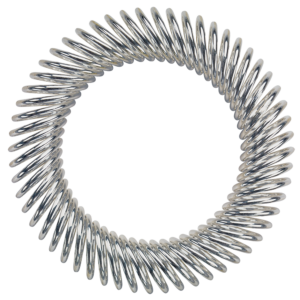Flexforce Canted coil springs, can be used as effective electrical conductors. They can provide reliable current conduction despite challenges such as vibration, dynamic conditions, and shock loadings where other conductor solutions would fail.
Situations That Pose a Challenge for Conduction
Certain operating conditions can make it challenging to achieve a solid connection for conduction. For example, vibration and shock loadings, such as those experienced in downhole tools for the petrochemical industry, can cause more traditional electrical connections to eventually work loose and risk the integrity of signal and power transfer.
Any time there is a high probability of motion, such as EV/HEV battery pack connections, there is also a risk that the integrity of the electrical connection could be compromised. In the power industry, issues can arise with heat and reliability for high-current applications that perform conduction, grounding, and isolation.
Rotating parts, high temperatures, and variations in loadings are also challenging for maintaining electrical connections and common to wind energy applications involving turbines. In addition, rotating parts in robotic end grippers and similar automation equipment pose similar issues.
Implantable devices, such as neurotransmitters and pacemakers, require electrical connections that must also be highly reliable, lightweight, and compact. In addition, lightweight design approaches are critical for many applications, including unmanned vehicles that must be lightweight to maximize their battery-constrained range.
And some applications, such as semiconductor fabrication, need to take advantage of solutions that can perform multiple purposes, such as conduction combined with latching/holding/locking or EMI shielding.
 Canted Coil Springs
Canted Coil Springs
Our Canted coil springs, also known as slanted or slanting coil springs, are often used as electrical conducting springs to achieve high integrity connections for applications such as those just described. However, several factors make these springs different, starting with their ability to maintain consistent force over a wide range of deflection.
The Individual coils that make up these springs maintain contact with the mating surface despite surface irregularities, misalignment, tolerance variations, and dimensional changes. In addition, they experience little to no compression set and are ideal for oddly shaped cross-sections.
When used as electrical conducting springs, the individual coils serve as multiple contact points for electrical conduction and grounding; essentially, each coil is a contact point. As long as one coil remains in contact with the surface, then the electrical connection is maintained.
Benefits of Canted Coil Springs for Conducting
There are numerous advantages over more traditional approaches when canted coil springs are used for electrical conduction. For example, canted coil springs can be designed to meet specific electrical requirements in addition to being manufactured from materials with high conductivity. Varying parameters such as spring diameter, wire diameter, coil height, canted angle, and the number of turns make it possible to tune amperage and electrical resistance for optimized solutions. In addition, platings such as gold or silver can be used to achieve ultra-low impedance.
Because of the extensive surface area of canted coil springs, they can transmit high power levels while generating less heat than traditional solutions. As a result, they provide outstanding heat-to-current carrying capacity even in extremely high temperatures. This same aspect is also essential in implantable devices where heat generation must be minimized for patient safety. In addition to their conducting capabilities, canted coil springs can serve as excellent EMI/RF shields for applications such as downhole tooling in oil exploration.
Canted coil springs support SWaP (space, weight, and power) requirements while reducing system complexity. This system simplification is often seen when they are used for mechanical fastening (latch, lock, or hold) in addition to electrical conduction. They make it possible to achieve far greater contact densities in smaller spaces than equivalent conductivity solutions. And one of the outstanding features of canted coil springs, as alluded to earlier, is their ability to provide specific force levels for fastening that include low force insertion.
As discussed in the previous section, these springs are able to maintain contact with surfaces despite factors such as impact and shock loadings, angular misalignment vibration, dimensional changes, and mating surface irregularities. In addition, they maintain performance in other harsh conditions by using materials and platings that are corrosion resistant. And canted coil springs, when designed and installed correctly, can reduce the possibility of conductor fatigue failure in relation to multiple insertion/removal cycles. Their minimal compression set also contributes to their extensive operational life.
Finally, canted coil springs are easy to clean and sanitize if needed for medical, pharmaceutical, food, and beverage applications.
Conclusion
Canted coil springs are used as highly reliable electrical conductors in industries such as medicine, transportation, aerospace, semiconductor fabrication, industrial, energy, and defense. From surgical bones saws to guided weaponry, canted coil springs have provided dependable, effective conductivity solutions.
Advanced EMC FlexForce Canted Coil Springs
For economical, reliable, SWaP-friendly conductivity solutions, Advanced EMC FlexForce canted coil springs may be the answer. The experts here at Advanced EMC can help you determine if a canted coil spring conductor will meet your design specifications and constraints. And if it does prove to be what you need, they will be there every step of the way until you have the conductor your design requires.
To learn more, you can also read 7 Things to Know About FlexForce Canted Coil Springs.

 Canted Coil Springs
Canted Coil Springs